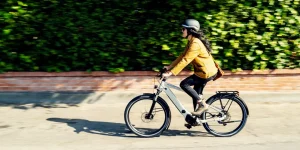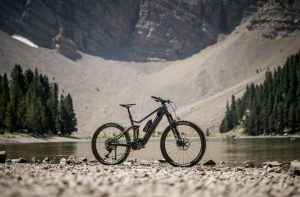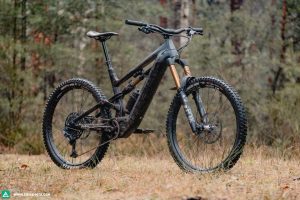More torque enhances performance but consider efficiency and cost.
The Mechanics of Torque in E-Bikes
Torque is the rotational equivalent of linear force and plays a critical role in the performance of an electric bicycle (e-bike). It directly influences how an e-bike responds to various riding conditions, such as acceleration and climbing hills. A motor’s torque output can determine the ease with which a bike starts from a stop and its ability to maintain speed on inclines.

Exploring the E-Bike’s Motor and Powertrain
- Motor Types: E-bikes typically use either a hub motor or a mid-drive motor. Hub motors are integrated into the wheel hub and directly apply torque to the wheel. Mid-drive motors, on the other hand, are mounted at the bike’s crank and pedal area, providing torque directly to the bike’s drivetrain.
- Power and Efficiency: The motor’s power, often measured in watts, correlates with its torque output. A motor with a higher wattage rating will generally offer more torque, enhancing the bike’s ability to accelerate and climb. However, higher power can also lead to reduced battery life, impacting the bike’s overall efficiency.
- Specifications: Motor specifications usually include a torque rating, expressed in Newton-meters (Nm). E-bike motors can vary widely, with torque ratings ranging from 40 Nm for basic models up to 85 Nm or more for high-performance bikes.
The Role of Torque in E-Bike Acceleration and Hill Climbing
- Acceleration: Torque is a pivotal factor in acceleration. E-bikes with higher torque offer brisker starts and can reach cruising speed more quickly. For instance, an e-bike with a torque rating of 60 Nm will typically accelerate faster than one with 40 Nm, assuming all other factors are equal.
- Hill Climbing: When it comes to hill climbing, torque is the main contributor to an e-bike’s ability to ascend slopes without undue strain on the rider. A higher torque output means the motor can better handle inclines, making steep hills feel almost flat.
- Drawbacks: While higher torque can improve performance, it can also lead to increased wear and tear on the bike’s components, such as chains and gears. Additionally, more powerful motors can be more expensive, both in initial cost and potential maintenance expenses.
The Benefits of Higher Torque in E-Bikes
Higher torque in e-bikes translates into several tangible benefits that enhance the overall riding experience, improve the bike’s utility, and offer a more satisfying ride across different types of terrain.
Enhanced Riding Experience in Various Terrains
- Immediate Response: E-bikes with high torque motors provide immediate power output, which is crucial for quick starts at traffic lights and stop signs, especially in urban settings.
- Smooth Ride: Riders can enjoy a smoother ride with consistent torque that delivers power without sudden surges, which is particularly noticeable when navigating hilly terrains.
- Adaptability: High torque e-bikes adapt more efficiently to changes in terrain, maintaining a steady speed without requiring the rider to pedal harder.
Improved Towing Capacity and Load Management
- Increased Load Capacity: E-bikes with higher torque can handle heavier loads, making them ideal for carrying groceries or equipment. Some models are rated to tow up to 300 pounds, including the weight of the rider and cargo.
- Stability Under Load: Higher torque ensures that the e-bike remains stable and responsive even when fully loaded or towing a trailer, which is essential for maintaining balance and control.
- Efficiency: While towing or carrying heavy loads, high-torque e-bikes maintain efficiency, providing sustained power without significant losses in battery life. For example, an e-bike with a torque of 80 Nm can maintain efficient power delivery without the need for frequent battery recharges, which is not the case for e-bikes with lower torque.
Optimal Torque for Different Riding Styles
Choosing the optimal torque for an e-bike greatly depends on the rider’s style and the typical terrain they will navigate. Different riding styles benefit from different torque settings to maximize efficiency, comfort, and bike longevity.
Urban Commuting and Casual Riding
- Torque Requirements: For urban commuting and casual riding, an e-bike with a torque range of 40-50 Nm is typically sufficient, providing enough power for flat city roads and slight inclines.
- Cost and Efficiency: E-bikes designed for urban environments tend to be more cost-effective, with prices ranging from $1,000 to $3,000. They offer a balance between power and efficiency, allowing riders to cover distances of 20-40 miles on a single charge.
- Speed Regulations: In many urban areas, e-bikes are subject to speed regulations. E-bikes in this torque range comply with these rules, typically not exceeding the speed limit of 20 mph on motor power alone.
Off-Road and Mountain Biking
- Higher Torque Needs: Off-road and mountain biking require higher torque, usually between 60-85 Nm, to tackle steep inclines and rough terrains effectively.
- Battery Life: While higher torque provides better performance on challenging terrains, it also consumes more battery power. Riders may experience a reduced range of 15-30 miles when riding in such conditions.
- Price Point: High-torque e-bikes suitable for off-road use often come at a higher price, ranging from $2,500 to over $5,000, reflecting the advanced materials and technology required to sustain the rigors of mountain biking.
How to Choose the Right Torque for Your E-Bike
Selecting the appropriate torque for your e-bike is pivotal to ensure that it meets your riding expectations and requirements. It involves understanding how torque impacts the ride, the cost, and the e-bike’s specifications.
Assessing Your Riding Needs and Preferences
- Daily Commutes: For daily commutes in urban settings, an e-bike with a torque between 40 to 50 Nm will suffice, offering a balance between speed and range.
- Terrain Types: If your route includes hilly terrains, consider e-bikes with torque upwards of 60 Nm to ensure comfortable rides without excessively draining the battery.
- Cargo Needs: Should you require to haul cargo or a trailer, look for e-bikes with at least 60 Nm of torque to handle the additional weight without compromising performance.
Understanding E-Bike Specifications and Torque Options
- Motor Types: Learn the differences between hub motors and mid-drive motors. Hub motors are simpler and typically found in e-bikes with lower torque, while mid-drive motors offer higher torque and better handling, especially for off-road conditions.
- Battery Efficiency: Higher torque motors may reduce the battery’s lifespan due to increased power draw. Check the battery specifications to ensure it matches the motor’s power requirements.
- Cost Implications: Higher torque e-bikes often command a higher price due to advanced technology. Prices can range from $2,500 for mid-range models to over $5,000 for high-end ones. Consider your budget and the value the e-bike presents over time.


